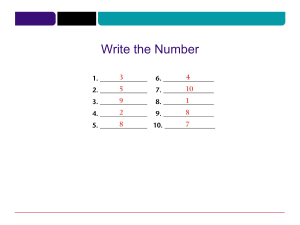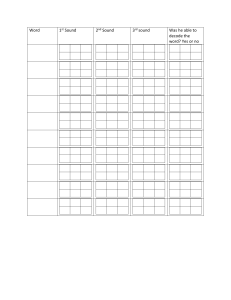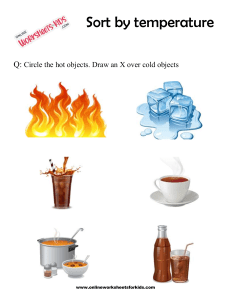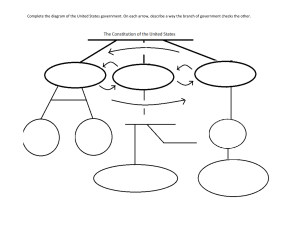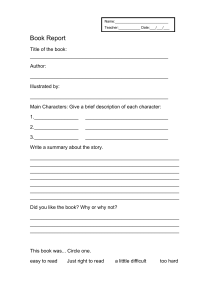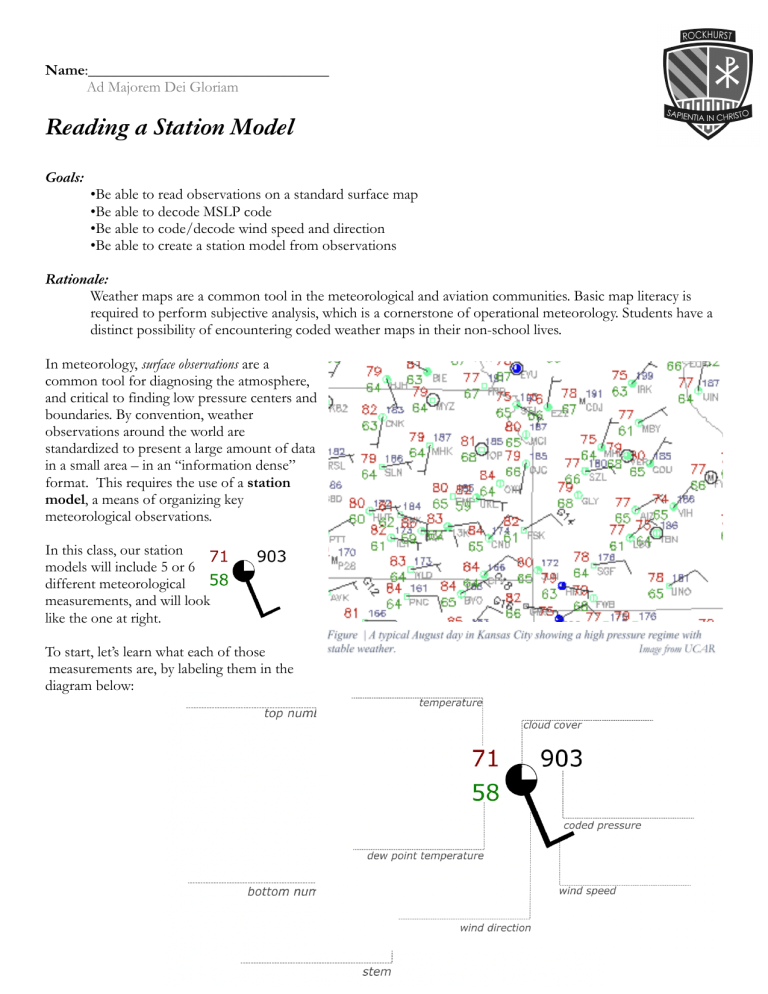
Name:________________________________ Ad Majorem Dei Gloriam Reading a Station Model Goals: •Be able to read observations on a standard surface map •Be able to decode MSLP code •Be able to code/decode wind speed and direction •Be able to create a station model from observations Rationale: Weather maps are a common tool in the meteorological and aviation communities. Basic map literacy is required to perform subjective analysis, which is a cornerstone of operational meteorology. Students have a distinct possibility of encountering coded weather maps in their non-school lives. In meteorology, surface observations are a common tool for diagnosing the atmosphere, and critical to finding low pressure centers and boundaries. By convention, weather observations around the world are standardized to present a large amount of data in a small area – in an “information dense” format. This requires the use of a station model, a means of organizing key meteorological observations. In this class, our station models will include 5 or 6 different meteorological measurements, and will look like the one at right. To start, let’s learn what each of those measurements are, by labeling them in the diagram below: It is important to notice that the units are standardized in the United States – that is, each observation will be in the same spot on a station model, and in the same dimensions. By convention, the units used are (label the diagram at right): Some of these units are familiar – likely temperature, cloud cover, and dew point – but the other measurements will need some help to have you decode them properly. Let’s start by looking at the winds. Wind direction: It is imperative to realize we describe wind direction according to where the winds come from. That is, a “east” wind blows starting in the east, ending in the west. This is for a practical reason: winds advect weather, and to make a forecast, we’re concerned with what is upstream of the wind a place is currently experiencing – what weather is being moved towards a location by the wind. Let’s start with a polar graph, with 0º/360º located at North on a compass rose, as shown at left. You can make an anchor point at the origin of the graph, which is represented by a • in this drawing. We are going to draw an arrow starting with this dot, and ending with an arrow head show where the wind is blowing towards. For example consider the two examples shown below: Realistically, we do not draw the wind rose behind the wind vector, and instead assume directions on a standard wind rose, as at right. Starting from the center origin, draw a wind vector depicting the following winds, remembering the arrow will point at where the wind is going. the A northeast wind A due west wind A wind from the southwest An ESE wind A wind from the NW A SSW wind. We could draw winds this way, making them different lengths to show their relative speeds. This is called a wind vector map, and it is useful for getting a feel for a meteorological setup. However, it is not precise enough for our practical purposes. You can see an example of this kind of map at the right. The most inconvenient element of this map type is you are not able to accurately know the wind speed at a given location – you can only know if it is relatively faster or slower. To solve this, meteorologists derived the wind barb, like the one shown below: I like to think of a wind barb like the fletching (the feathers) on the back of an arrow used in archery. Think of a wind barb as the undrawn back of a normal arrow. We do not draw the arrow – only the stem and the barbs. We will get some practice with this concept soon – but first we need to know how determine the wind speed using the flags on the wind barb. Before we go on, it’s best to see if you can see the wind direction on a real weather map. On the map below, draw a vector field by drawing arrows showing the wind direction at least 10 stations. Don’t worry about the vector length – just draw each arrow at the same length. Winds are measured in knots, with 1kt = 1.15mph. A chart of windspeeds converted is provided at right. We plot the wind speed in knots, though in practice you can assume the winds are plotted in mph and be close enough in most cases, especially at low wind speeds. To show windspeeds, we use varying numbers of flags that attach to the wind barb, with the sum of all flags showing the wind speed. We round winds to the nearest 5kt measurement to plot them on a weather map. As such, you can use the flag structure at right to depict any wind speed on earth: Below, you will see a few examples of wind barbs showing different wind speeds. Before we move on, let’s make sure you can draw the right numbers of flags. A 25kt wind A 90kt wind A 144mph wind We can combine these concepts – the wind barb and flags – to show wind barbs that give both the direction and speed of the wind, as shown at right: Note that we do not draw arrow heads on wind barbs. Instead, they terminate at the origin of our compass rose polar graph. This lets us bring together the two concepts to draw a wind barb arbitrarily for any wind speed and direction. Let’s do four of those below: A southwest wind at 15kts Due north wind at 5kts A ESE wind going 23mph NNW at 115mph Figure 11 | Wind field at 250mb at 18Z on 22-Aug 2022. Image from the GFS via Plymouth State University We’re not done with the station model, but we’re through the most difficult element, the winds. Mercifully, the cloud cover is easy – it is just a pie chart showing the amount of the sky covered. Technically, these pie charts are known as oktas, but that’s extraneous information except to the largest weather nerds. To simplify this for our course, we’ll just consider the 0%, 25%, 50%, 75%, and 100% Oktas. This leaves pressure as the last thing we need to learn. All pressures on a surface map are normalized to the same pressure level known as mean sea level pressure (MSLP). This allows us to study differences in pressure across the surface without having to think about the changes in pressure that result from changing elevation. These are measured in millibars, which are the same thing as hectopascal (hPa), the proper metric unit. However, meteorologists tend to use mb, even though it’s not precisely correct. To decode a station model’s pressure, look at the three digits in the upper-right-hand corner of the station model – as circled with the dashed line at right. These represent the last three digits of the station's sea-level pressure, expressed to the nearest tenth of a millibar. To decode the pressure reading, you must first add a decimal in front of the right-most digit. Then you need to place either a "9" or a "10" in front of the three digits. If your pressure starts with a number between 0 and 4, start with a 10. If your pressure starts with a number between 5 and 9, start with a 9. This isn’t exactly correct – very strong hurricanes being the obvious exception – but we do not work with those frequently. For this class, the rules above will always apply. So let’s decode the pressure shown here Decode the following pressures: 876 234 999 779 312 003 Name:________________________________ Ad Majorem Dei Gloriam Station Models and Wind Barbs WORK (an introduction to map analysis) This will be graded. 1.) This is a basic station model in the United States as we will be using it in this class. At this station, what is the: a) Temperature (ºF) ____________________ b) Dew Point (Td, ºF) ___________________ c) Mean Sea Level Pressure (mb) _________________ d) Wind Speed (kts) _____________________ e) Wind Direction (circle one) N NE E SE S SW W NW 2.) In the boxes below, draw wind barbs showing the indicated wind speeds and directions A 5kt wind from the due W A 25kt SE wind A 65 kt SW wind 3.) This is a station plot from Kansas City at 9AM CST, 28-Aug-21. a) Temperature (ºF) ____________________ b) Dew Point (Td, ºF) ___________________ c) Wind Speed (kts) _____________________ d.) MSLP (hPa) ______________________ e) Wind Direction (circle one) N NE E SE S SW W NW f) cloud cover percent __________________ 4.) Here, I’ve prepared a station plot of observed conditions on March 10, 2021 centered on Nebraska City. a.) Look at the station models I’ve put a box and circle around. Explain why you think these stations do or do not represent air that came from the same source region (place the air originated) ____________________________________________________________________________________ b.) The circled station model does not include a pressure measurement. Make a guess as to why. c.) Look at the station with a square around it. What is its: a) Temperature (ºF) ____________________ b) Dew Point (Td, ºF) ___________________ c) Wind Speed (kts) _____________________ d.) MSLP (hPa) ______________________ e) Wind Direction (circle one) N NE E SE S SW W NW f.) Cloud cover percent: _________________ 5.) I’ve prepared a plot of surface conditions on April 14, 2012, centered on Salina, KS. This was a major tornado outbreak, producing several strong, long-lived tornadoes, like the one at right (Kanopolis EF4 tornado, 50 mile path). This day is important to Mr. Nendick as it was his first tornado on a chase that he saw from start to finish (though not the Kanopolis storm, he chose to target weaker tornadoes further north). 5.) 6.) a.) I’ve put a box around 2 stations. They are clearly from two different source regions. What are three ways that you know the air mass was different in these two locations? (read: what’s different about these two locations?) _______________________________________________________________________________________ _______________________________________________________________________________________ _______________________________________________________________________________________ _______________________________________________________________________________________ b.) I want you to realize that if you were in Kansas on this day, you’d realize something strange was up. Check out the observation that I’ve circled: what stands out to you telling you this isn’t a normal spring day? _______________________________________________________________________________________ _______________________________________________________________________________________ _______________________________________________________________________________________ 6.) You’ve been working with station models more now, but I need you to really get these down. So I’d like you to draw the three station models I’m asking for below. A compass rose is provided to help you with wind directions. Temperature: 38ºF Dew point 12ºF Pressure 1009.2 mb Winds NW @15kts Mostly (75%) clear Temperature 78.6ºF Dew point 69.6ºF Pressure 990.7 mb Winds S @ 55kt Partly (50%) cloudy 7.) This is a storm off the south coast of Alaska. Surface station models are overlaid on an infrared satellite image. I know this is a harder to read picture, but this is the way meteorologists often interact with data. a.) At which station is the pressure greater? (Circle one) Square Circle b.) Which station has a NW wind? (circle one) Square Circle c.) Which station has more moisture in the air? (circle one) Square Circle Temperature -12ºF Dew Point -20ºF Pressure 1021.4 mb Winds calm Full sun
